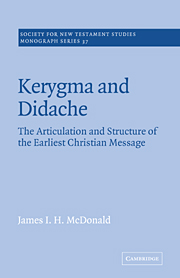2 - Paraclesis and homily
Published online by Cambridge University Press: 06 November 2009
Summary
After the reading of the law and the prophets, the rulers of the synagogue sent to them, saying, ‘Brethren, if you have any word of exhortation (logos paraclēseōs) for the people, say it’.
(Acts 13:15)Bear with my word of exhortation (logou tēs paraclēseōs).
(Heb. 13: 22)Popular preaching in the Graeco-Roman world
With paraclesis, ‘exhortation’, and homilia, ‘familiar converse’, we enter the world of popular preaching. The hinterland of paraclesis is permeated with religious meaning: ‘comfort’, ‘consolation’, ‘asking for help’; and as ‘exhortation’ the word can denote both summons to decision and encouragement to persevere. The ethos of homilia, the term later applied to popular preaching, is one of intimacy and familiarity, of friendly converse and persuasive argumentation, with overtones of serious intent and instruction. The world of the first century was as open to moralistic discourse as the modern world is closed to it. The church began in a cultural environment in which preaching was a basic mode of communication.
Behind this cultural phenomenon stood centuries of development and preparation, the roots of which were embedded in the Greek situation bequeathed to posterity by Alexander. The soil was the international culture, based on Hellenism. Yet such hellenistic internationalism contained within itself immense tensions.
- Type
- Chapter
- Information
- Kerygma and DidacheThe Articulation and Structure of the Earliest Christian Message, pp. 39 - 68Publisher: Cambridge University PressPrint publication year: 1980

